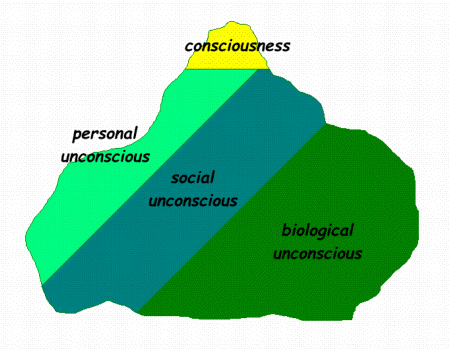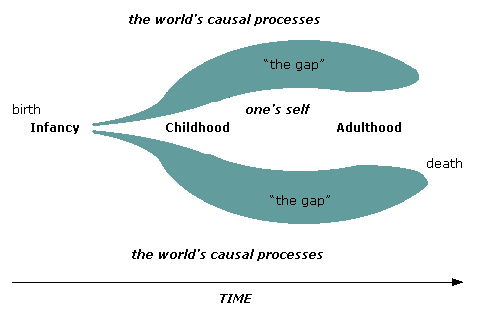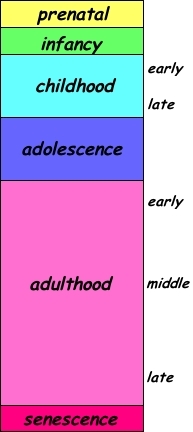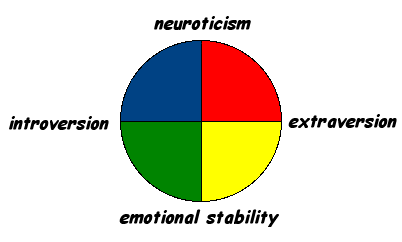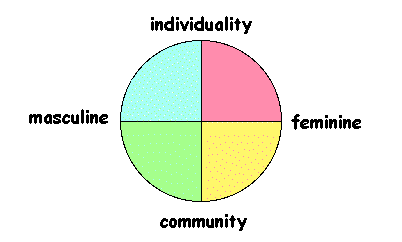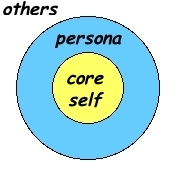The
Ultimate Theory of Personality
Dr. C. George Boeree
La théorie ultime de la personnalité (In French: Anna Chekovsky)
Крайната теория на личността (in Bulgarian: Borisa Kovacevic)
Ostateczna teoria osobowości (in Polish: Daniel Gruber)
人格的终极理论 (in Chinese: Patrick Chang)
After a semester of Personality theories -- Freud and Jung and
Rogers
and Frankl and Bandura and Eysenck, etc., etc., etc. -- students often
ask, once again, isn’t there one theory we can trust and use
with
confidence? Can’t we narrow it down a bit? Tell us, what is
right and what is not!
Well, unfortunately, Personality is not yet a science, at least not
in the sense that Biology or Chemistry are sciences. In those
fields,
although there is disagreement about details and the latest findings,
there
is a common body of knowledge that few people in the field argue
about.
Not so, obviously, in Personality.
However, there are slowly emerging ideas that seem to pop up again
and
again in different theories, often with different names, but there
none-the-less.
Sometimes they occur in theories that are otherwise quite different, or
that come from a different perspective, such as clinical versus
experimental
versus factor analysis versus phenomenological. Perhaps the field
will indeed become a science, perhaps not too far in the future!
I know I’m excited!
So, I have taken the bull by the cojones,
so to speak, and have
compiled
this little list of things I see as being, if not universal, at least
more
likely features of the future ultimate theory of personality.
Here
goes...
Consciousness and the unconscious
This, of course, is one of Freud’s greatest contribution. Even
if he
didn’t invent the terms, he certainly was responsible for popularizing
them! Many theories postulate some sort of unconscious, not
necessarily as a
place where our worst fears bubble and boil, but as a way of accounting
for the many things that influence us without our full awareness.
We can pick out three aspects of the unconscious.
The first is biological. We come into this
life
with something like Freud's id or Jung's collective
unconscious
in place. It is likely composed of whatever instincts
remain
a part of our human nature, plus our temperament or inborn
personality,
and perhaps the preprogramming for stages of life. This
biological
unconscious overlaps in part with the existentialist concept of thrownness.
As for possible instincts, I would nominate three
“complexes”
of them: A mating complex, an assertive complex,
and
a nurturant (or social) complex.
Second, there is the social unconscious (as Fromm calls it),
which
actually resembles Freud’s superego more than Freud's id.
It
might
include our language, social taboos, cultural habits, and so on.
It includes all the cultural things we were surrounded with in our
childhood and have learned so well that they
have become "second nature" to us! The negative aspects of the
social unconscious
overlaps with the existential idea of fallenness and with
Rogers’
idea
of conditions of worth.
And third, there is the personal unconscious (to borrow
Jung’s
term), perhaps understood as the unconscious aspect of the
ego.
It is composed of our idiosyncratic habits, the more personal
things we
have learned so well we no longer need to be conscious of them in order
to enact them -- like knowing how to drive so well that we can comb our
hair, talk on a cell phone, light a cigarette, and notice the
attractive
person in the rear view mirror all at the same time (at least until you
run off the road into a tree).
Included among those well-learned things might be the defense
mechanisms. With these we ignore, with habitual efficiency,
uncomfortable
realities in order to save our sense of self-worth. More a little
later....
But let's not get overly enthusiastic about the unconscious! Few
psychologists today view it as the location of our true selves, the
answer to all our problems, or some deep psychic well that connects us
with the universe or God! It is where the more-or-less automatic
processes of instinct and the well-learned do their thing.
All this is in contrast to (in fact defined
in contrast to) consciousness
or awareness. Other than instincts and perhaps a few
associations learned by classical conditioning, it seems that all
things going into or out of our psyches pass through awareness.
What consciousness is will be a question for a good
while longer. It’s not terribly available to traditional research
methods! But for now, we can see it as the ability to experience
reality (outer and inner) together with its meaning or relevance to
ourselves
(as biological, social, and even individual organisms). Or the
ability to be open to the world while maintaining a degree of
separation in the form of an integrated self.
I would add that it may be consciousness that also provides us with
the freedom to choose among the choices available to us -- i.e. self-determination (if not
full-blown free
will).
Perhaps the most important thing to keep in mind about
consciousness
is that it is personal. It is yours and yours
alone.
And it is within this personal consciousness that all of your
"psychology"
takes place. Everything you feel, perceive, think, and do is phenomenological, i.e.
experience that is not just based on a reality that stands outside of
you, but on your subjective view of reality as well, a view
which may be significantly
different
from mine! Therefore, in order to understand people, we need to
understand
them from the inside. This little fact is what makes psychology
so much more difficult than the physical sciences!
Self-determination
Free will doesn't fit very well with science. It seems to require
"supernatural" involvement in the natural world. But we really
don't
have to be "above" the natural world in order to have a degree of
freedom within that world.
The baby begins life nearly as intimately connected with his or her
world as in the womb. As we develop from babies into adults, we
gradually separate ourselves from the world. Our interior causal
processes - especially mental processes - become increasingly
independent of the causal processes outside of us. A gap develops
that
allows us to be influenced by outside situations, but not necessarily
determined by them.
This gap is like a large river: The man on the opposite bank can
wave
and jump and yell all he wants -- he cannot directly affect us.
But we
can listen to him or interpret his semaphore signals. We can
treat his
antics as information to add to all the information we have gathered
over our lives, and use that information to influence our decisions --
influence, but not cause.
By the end of life, some of us are nearly impervious to what others
think about us, can rise above nearly any threat or seductive promise,
can ignore nearly any kind of urge or pain. We are still
determined -
but little in our immediate situation is more than information we
utilize in making our decisions. This may not be free will in the
absolute sense, but it is certainly self-determination.
As a middle-aged man, I have dozens of years of experiences -- my
childhood, my cultural inheritance, the books I've read, conversations
with friends, my own thoughts -- that have made me who I am
today. All
this is on top of my unique genetics and other physical realities of
who I am. The things that happen to me now are experienced
through
this mass of uniqueness, and my responses depend, not only on my
present situation, but on all that I am.
Stages
Stages are something most personality theorists shy away from.
Freud and Erikson are the obvious exceptions, as is the
developmentalist
Piaget. And yet there is a very biological basis for the
idea.
We can, on pure biology, separate out at least three stages: the
fetus,
the child, and the adult. This is, in fact,
completely
parallel to the egg, caterpillar, butterfly example we learned in high
school biology!
In addition, we can see three transitional stages: infancy,
adolescence, and senescence.
Infancy is not, actually, found in more primitive
animals,
and is greatly exaggerated in humans. We are, in a sense, all
born
prematurely. Perhaps this was the result of an evolutionary
dilemma:
How can an upright creature give birth to a baby with a large head
without
killing the mom? That’s right: Give birth before it gets
too
big!
What that does for us is more than just let us live long
enough
to give birth again. It lets the infant soak up information much
earlier, and in a different way. It would seem that for the first
6 to 12 months, our neural development is as yet incomplete. As
we
learn, we actually create
certain neural paths, rather than just
tightening
synapses as we do later in life. It’s as if we were actually
learning
instincts!
Adolescence also qualifies, I believe, as a stage. The
transition
from child to adult involves rather massive hormonal changes
accompanied
by a growth spurt like you hadn’t seen since you were two! It is
hard for me to conceive of these changes not having some effect on us
psychologically.
Senescence is, strictly speaking, the last year or so of a
full
life, during which time the organs begin to deteriorate and shut
down.
We don't usually see this as a stage, and in fact most people never
reach
it (accidents and diseases usually beat senescence to the
punch).
But socially speaking, in our culture we certainly prepare ourselves
for
this inevitability, and that might constitute a social stage, if not a
biological one.
As this last point suggests, there are certainly cultural additions we
can make. In our
culture, there is a sharp transition from
preschool
child to school child, and another sharp transition from single adult
to
married adult. For all the power of biology, these social stages can be
every bit as powerful.
To venture a guess as to the psychological side of these biological
stages: The fetus focuses on biological development,
which
is
transformed by the presence of others in the infant into ego
development
in the child. In turn, the ego development of the child is
transformed by the
advent
of sexuality in adolescence into the “trans-ego” or social
development
of the adult.
Another way to look at it goes like this: In the fetal and
infancy
stages, we lay the groundwork and
develop our temperaments (founded in hormones and
neurotransmitters). In the child stage, we develop a personality
(founded in
habits). In adolescence, continuing into adulthood, we
develop character
(based on conscious decision-making).
Temperament
Temperament is what we call that part of our personalities or
characters
that is built-in to us genetically. Consequentially, although
there
is always a degree of flexibility allowed, to a large extent we "are"
our
temperaments for our whole lives. Temperament is very in right
now, and justifiably so. Jung led the way, Eysenck made it more
scientifically
acceptable, and the Big Five made it official.
Nearly everyone I know of accepts two dimensions of personality as
established
before birth, probably genetically:
- emotional stability (AKA neuroticism...) and
- extraversion-introversion (AKA sociability, surgency...).
Three more seem to have popular approval:
- conscientiousness (AKA anality, judging-perceiving...)
- agreeableness (AKA warmth, feeling-thinking...)
- openness (AKA culture, intellect, intuiting-sensing...)
- possibly an aspect of intelligence
And there are three other contenders that are a little harder to place:
- psychoticism (Eysenck) - perhaps a combination of
dis-agreeableness and non-conscientiousness
- impulsivity (Buss and Plomin) - perhaps an aspect of
non-conscientiousness
- activity (Buss and Plomin) - perhaps an aspect of
extraversion
But we need to beware: These results of factor analysis may be as
much a reflection of language as of true genetic foundations of
personality. As we continue to develop our understanding of
genetics and the precise relationships of protein synthesis to brain
function, we may find that there are hundreds of "temperaments," or
find instead that the concept doesn't hold up at all.
Learning
With the exception of Skinner, Bandura, Kelly, and a few others,
learning is
rather
taken for granted by most personality theorists. But I suspect it
shouldn’t be. We can postulate at least three kinds of learning:
basic,
social,
and verbal.
Basic learning includes the behaviorist
Pavlovian
and
Skinnerian conditioning, of course -- getting feedback from
your
environment. It also includes the latent learning
that
E. C. Tolman talked about: We learn about our environment just by
being in it!
George Kelly’s way of looking at basic learning derives
from
the work of Snygg and Combs, which in turn derives from the Gestalt
psychologists:
We learn to differentiate one thing from another on the basis
of
the consequences. Either way, behaviorist or gestalt, this kind
of
learning requires little in the way of consciousness.
There is also environmental learning that involves other people.
When
junior
does something that mom or dad does not approve of -- he may be punished
in some fashion. Likewise, he may be rewarded when he
does
something right for a change. This is also usually called
conditioning,
but the fact that it involves others means it is also social learning,
and so fraught with extra difficulties.
For example, if every time your run into a tree your head
hurts,
you will stop running into the tree. On the other hand, if every
time you say "shit!" your dad hits you upside the head, you may stop...
or you may avoid dad, say shit under your breath, begin to hate your
father
and authority in general, start beating up little kids after school,
and
so on, until prison effectively stops the behavior. These kind of
things seldom happen with trees.
Social learning includes vicarious learning (noticing
and
recalling the kinds of environmental feedback and social conditioning
other
people get) and imitation (Bandura’s modeling).
This
kind of learning is probably the most significant for the development
of
personality. It can be either conscious, as when we are watching
an artist to learn their technique, or unconscious, as when we grow up
to be disconcertingly like our parents.
And there’s verbal learning -- learning not from the
environment
or the behavior of others, but from words. Culturally, this is,
of
course, a highly significant form of learning. Most of the
learning
we do in our many many years of schooling is verbal. And yet we
don’t
know that much about it at all!
One thing is certain: The old models of the rat with his
conditioned and shaped behavior, and of the computer with its
programming, are not very good ones. If you really need a simple
metaphor for human learning, you are better off thinking of people -
especially children - as sponges!
Emotions
Emotions or feelings have always been a key point of interest in
personality
theories.
At the lowest level, we have pain and pleasure, which
are
really more like sensations than feelings. There is also
psychological
pain and pleasure -- call them distress and delight --
which
may be the root of all other emotions. Distress is what we feel
when
the events of the world are more than we can handle. Delight is
what
we feel when we discover that we can handle them after all!
Anxiety is a favorite topic in personality
theories.
Although many definitions have been proposed for anxiety, they tend to
revolve around unnecessary or inappropriate fear. Kelly notes
that it is actually the anticipation of a fearful situation, accurately
or not. Fear,
in
turn, is usually understood as involving the perception of imminent
harm,
physical or psychological. These definitions serve well for most
circumstances.
Guilt is another key emotion. Related to shame, it is usually
understood
as the feelings aroused when one contravenes internalized social
rules.
Kelly provides a useful elaboration: He defines it as the feeling
we get when we contravene our own self-definition (which may or may not
involve those standard social rules!). Existentialists add
another
detail by suggesting that guilt is closely related to the sense of regret
about opportunities not taken.
Sadness is the experience of the world not being as it
should
be, with the added notion that we have no power to alter the
situation. Instead, there is a need to alter ourselves --
something we are innately reluctant to do! Grief
would be the obvious extreme example, and depression could be
defined
as unrealistic sadness that continues long after the original
situation.
Anger is similar to sadness: The world is not as it
should
be. But now, there's the added notion that we must energize
ourselves
to change the situation. When we act on our anger, it becomes aggression.
Anger and aggression are not necessarily bad: It is our anger at
social injustices, for example, and aggressive action to correct them,
that makes for positive social change! Unrealistic anger, the
kind we hang on to despite the suffering it
causes us and the people around us, could be labelled hostility.
There are, of course, many other emotions and emotional shadings we
could
try to define, but that's for another time and place. Just one
more
thing should be noted: It appears that, where there is
consciousness,
there is emotion -- at very least an emotional tone or mood. As
the existentialists point out, we just cannot not care.
Motivation
Now here’s a more difficult one: Motivation is central to most
theories of personality, and the variety seems unending! But
perhaps
a little organization will help.
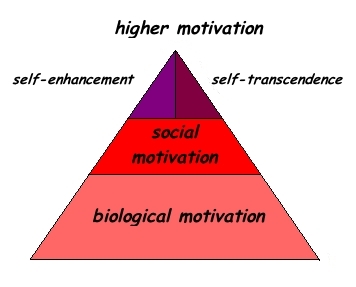
First, there are the biological motivations, mostly
instinctual (although addictions are acquired). There is our need
for air, water, food. There is the need for pain-avoidance.
There is the need for pleasure: pleasant touch, comforting,
sex.
We may want to add the instinct complexes mentioned
earlier:
mating, assertiveness, nurturance. All theories accept
the idea of biological motivation,
although
they differ wildly about their importance relative to each other as
well
as to other kinds of motivation.
Second, there are the social motivations. They may
build
on the biological motivations, especially the instinct complexes, but
they
vary enormously depending upon culture and even individual social
situations
and learning. Because they are learned so well and early, we
could
borrow Maslow’s term and call them instinctoid. Social
motivation may include our need for acceptance, attention, and approval
(Rogers’ positive
regard), as well as those forms of self-esteem that are based on
such
approval. Shame and guilt are clearly factors in social
motivation, as is pride.
Parallel to the idea of a personal unconscious, we might also
postulate personal motivations.
These would be learned from our unique and idiosyncratic experiences.
Last, but not least, there are higher motivations.
These
are conscious and we perceive them as providing our lives with meaning.
There appear to be two broad kinds:
The first, self-enhancement.
Here we find those motivations that
lead us to extend ourselves beyond mere survival and comfort, that lead
us to be "all that we can be." It includes
such
motives as desire to learn more than is needed, attain mastery beyond
mere competence, and
creativity. Adler
might call it striving for superiority or perfection.
The second, self-transcendence,
Most clearly defined by Viktor Frankl, it is an outgrowth of our
natural tendencies to care about our children, families, friends, and
lovers, and our innate capacity for empathy. It includes
altruism, love, compassion, and Adler’s social
concern. Perhaps it also includes other experiences that take us
out of ourselves, such as music, art, literature, dance, and the beauty
of nature.
Erikson in particular talks
about these two motives, especially in the adult stages. Whether
they are
simply
derivatives of the lower needs or are indeed something more, will
remain
a point of discussion for many years into the future!
It seems to me that all of the preceding, and probably a few I’ve
missed,
qualify as motivations. Disagreements as to which are most
significant
are perhaps misguided -- perhaps that differs from individual to
individual!
And the possibility that higher motivations derive from lower ones in
no
way diminishes their significance. Rollo May's idea of a large
number of daimons, unique to each individual, may be the best
approach.
Balance
Another common theme in personality theories is the idea of balance. Freud, for example,
felt that all of life's "crises" were best resolved at some midpoint
between two extremes -- Potty training was to be accomplished not too
early, not too late, not too harshly, not too leniently. The
result of a balanced upbringing would be a balanced personality -- not
too retentive, not too expulsive, for example.
Even when talking about positive experiences, such as learning to act
on our imaginations, we need to recognize that those positive
experiences need to be tempered with at least a small amount of
negative experiences. For example, without a little shame and
self-doubt,
Erikson tells us, acting on our imaginations becomes ruthlessness.
Carl Jung's entire theory revolves around balance, especially between anima and animus and between the ego and the shadow. The former in
particular has received a great deal of attention and empirical
support: Androgenous
people (those who combine qualities of both the "feminine" and the
"masculine") appear to be mentally healthier. The latter also has
support: People who are able to think in "shades of gray" are much more mature
than those who see everything as black and white, good vs. evil, us vs.
them. Ego vs shadow might also be understood as a need to balance
rationality with emotion.
The balancing act that has gotten the most attention from
personality psychologists is the balancing of our desires for individuality and community. This idea
originated with Otto Rank's
contrast between a desire for both "life"
(our drive towards individuality) and "death"
(our drive towards union with others), as well as the corresponding
fears (isolation vs. engulfment). Rollo May uses the
words will and love, others use
words such as autonomy and homonymy, agency and communion, egoism and altruism, and so on. Founded
in our instincts for assertiveness and nurturance, in their highest
forms they are self-enhancement and self-transcendence, respectively.
Whatever the words, the balance to be achieved is between the impulse
to serve oneself (becoming all one can be as an individual) and the
impulse to serve
others (become one with the universe of others). But serve only
yourself,
and you end up alone; serve only others, and you lose your
identity. Instead, one must serve oneself in order to serve
others well, and serve others in order to best serve oneself.
At some point the two aren't so much balanced as working
synergistically. Here's a nice quote from good old Einstein that
sums it up nicely:
Man
is, at one and the same time, a solitary being and a social
being. As a solitary being, he attempts to protect his own existence
and that of those who are closest to him, to satisfy his personal
desires, and to develop his innate abilities. As a social being,
he seeks to gain the recognition and affection of his fellow human
beings, to share in their pleasures, to comfort them in their
sorrows, and to improve their conditions of life. Only the existence
of these varied, frequently conflicting strivings accounts for
the special character of a man, and their specific combination
determines the extent to which an individual can achieve an inner
equilibrium and can contribute to the well-being of society.
(Einstein, "Why Socialism?" in Monthly Review, NY, May 1949)
Neurosis
Life is filled with stress.
Many people's difficulties begin with childhood experiences of
abuse,
neglect, poverty, sickness, parent's sicknesses or death, parental
psychological
problems, divorce, immigration, accidents, deformities, etc.
Sometimes,
we are strong enough, or have enough support, to weather these
storms.
More often, we find that these experiences leave us with an on-going
apprehension
about life. We end up suffering from anxiety, guilt, sadness,
anger...
not just as a direct result of the specific experience, but because we
no longer trust life.
A child with loving parents and compassionate relations, peers, and
teachers may well be able to cope with these problems. On the
other
hand, a lack of support, a lack of what Rogers calls positive
regard,
can
leave even a child blessed with a comfortable environment troubled with
self-doubt and insecurity.
Many of our theories were developed in order to help those who
cannot
cope, and looking at Adler, Horney, Rogers, Bandura, and others, we
find
a great deal of agreement as to the details. As I said a moment
ago,
in order to cope with life's difficulties, we need positive regard -- a
little love, approval, respect, attention.... But others often
make
that love and approval conditional upon meeting certain
standards,
not all of which we can meet. Over time, we learn to judge
ourselves
by those standards. It is this incongruence (Rogers’
term)
between what we need and what we allow ourselves that leaves us with low
self-esteem, or what others call a poor self-concept or an inferiority
complex.
There is a real advantage to the idea of
inferiority over
self-esteem: It is rare to have an overall sense of low
self-esteem. Instead, most people have a sense of inferiority in
some domains and not in others. Acknowledging the specificity of
inferiority allows us to focus in on possible remedies, while just
saying someone suffers from low self-esteem leaves us with little sense
of where to start!
Confronted with the difficulties of life, lacking in the support of
others, and not even enjoying confidence in ourselves, we find we must
defend ourselves however we can. We can list a large number of defense
mechanisms, as Anna Freud did, or we might be able to simplify a
little,
like Carl Rogers: We defend our sensitive egos by denial
and rationalization.
Denial (perhaps including repression) is the attempt to block
the offending
experiences directly, at
the cost of emotional exhaustion.
Rationalization (including, perhaps, perceptual distortion) is a more
sophisticated and
less
exhausting way of dealing with the offending information by working
around
it.
Either way, they are lies we tell ourselves and others in order to
minimize
the impact of that incongruence between our need for love and security
and what is afforded to us. We use these lies because they help,
actually. But they only help in the short run: Over time,
they
lead us into a possibly serious misunderstanding of how the world
(especially
other people) works, and of who, in fact, we are.
For those people who are, perhaps, a bit stronger than those who
succumb to neuroses, we still find
suffering in the form of alienation:
There develops a split between the deeper, "truer" core self within,
and the
persona (to borrow Jung's term)
that we present to the outside world to attempt to meet with those conditions of worth that Rogers
talks about. We feel inauthentic,
false, phony, dishonest
on the one hand, and misunderstood or unappreciated on the other.
Over the long haul, this is likely to lead to depression and withdrawal
from social life. But sometimes, alienation can lead to new
perspectives on life and some remarkably creative insights.
Perhaps we owe a good portion of our art, music, and literature to
these same people.
At the other end of the spectrum are those people whose psychological
suffering is founded on physiological
problems. Schizophrenia,
although it certainly has some sizable social and psychological causes,
seems to have a considerable physiological component. Other
disorders, such as bipolar, major depression, and obsessive-compulsive
disorders, improve with the use of medications that enhance the effects
of our own neurotransmitters. The borderline between psychology
and physiology is becoming increasingly blurry!
Coping strategies
People troubled by neuroses will be also find themselves attracted
to
certain patterns of living that to one degree or another keep the
psychological
pain at bay: They may become alcoholics, or work-aholics, or sex
addicts, or they may become obsessed with cleanliness or physical
health,
etc. These patterns can involve unusual behaviors, emotional
attachments,
obsessive thoughts, etc. Binswanger calls these patterns themes
and they are similar to Horney's neurotic needs,
Ellis's irrational beliefs, and the behaviorists' maladaptive
habits.
Many theorists see a certain order among these themes, and classify
them into four or five categories, which Horney calls coping
strategies.
Fromm calls them orientations, Freud uses character types....
They are, perhaps, the result of an interaction between a person's
temperament
and the specific stressors they must deal with.
There are two coping strategies we can readily agree on:
The dependent style is characterized by a sense of
inferiority
and weakness, but also involves a strong -- perhaps desperate -- use of
manipulation of others. It is also referred to as oral passive,
getting, leaning, compliant, or receptive.
The aggressive style is characterized by aggressive
posturing
that serves to temporarily diminish a sense of inferiority -- i.e. the
superiority complex! When you feel bad about yourself, beat or
humiliate
someone else. This is also known as oral aggressive, ruling,
dominant, or exploitative.
From there, things get more uncertain.
A third candidate is the perfectionist style.
This type of person attempts to actually reach the excessively
difficult
standards they have accepted for themselves -- or at least pretend to
reach
them. They tend to be emotionally detached from others, and to
dislike
depending on them. It is also known as the anal retentive or hoarding
type.
A fourth candidate is the schizoid style, AKA, the avoiding
or withdrawing type. This kind of person attempts to
remove
him- or herself from most if not all social interaction. They
tend
to be somber, psychologically detached, sometimes angry at the whole
world, and
potentially
violent.
And a last, fifth candidate is the infantile style, AKA,
the
phallic or marketing style. These people avoid
responsibility
by essentially extending their childhoods into adulthood. They
are
obsessed with youth, fun, adventure, and even high risk
activities.
They tend to be shallow and hedonistic.
One could argue that the most common coping strategy of all -- most
common
because it works so well -- is conventionality, "busy-ness,"
getting
lost in the day-to-day. It will be up to future personality
researchers
to determine which of these are true styles, if the idea of a few
styles
holds up, or if we should stick to a more individualistic way of
describing
people's coping.
Therapy
It is somewhat surprising that, for all the variation in theories,
there
is considerable agreement regarding therapy.
First, there is an emphasis on self-awareness or,
as
Freud put it, making the unconscious conscious. We encourage our
clients to understand their biological, social, and personal
unconscious
and related motivations, to examine the conflicts between their needs
and the
standards society and they themselves impose, and to look behind their
defensive posturings.
We are also taught to encourage our clients to discover more conscious,
higher
motivations -- meaning the development of competence, creativity,
and
compassion,
becoming valuable to oneself and to others....
And the means of therapy? We are taught to use genuinely caring
dialog,
and to provide support (not management or control) with a goal
of
eventual autonomy for the client.
Now, each theory has its own set of preferred techniques. Some,
such
as the radical behaviorist approach, insist that techniques are all you
need. Others, such as Rogers’ approach, suggest that you don’t
need
techniques at all, just an empathic, respectful, and honest personal
presence.
Probably the majority of therapists, however, follow the middle path
and
use a few techniques that they have found useful and that fit their
clients’
and their own personalities.
In addition, we now have a fairly reliable set of drugs that appear to help. Our
understanding of the physiological bases for psychological problems has
been growing rapidly, and, while that understanding is far from
complete, it has allowed us to help people more effectively. Most
therapists are still hesitant to rely entirely on medications, perhaps
rightly so. But these medications certainly seem to help in
emergency situations and for those whose suffering just doesn't respond
to our talk therapies.
Conclusions
Even among our list of consistencies, we can find some
"metaconsistencies."
Being a visual sort, I like to put things into graphic form. So
here
goes:
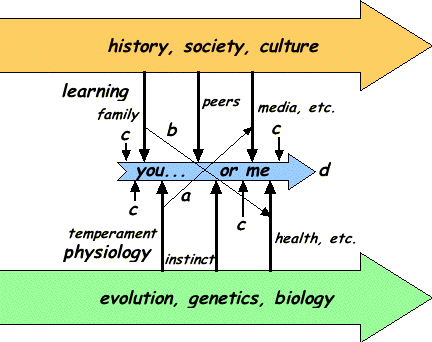
What you see here is "poor me" (or "poor you"), at the center of
enormous
forces. At top, we have history,
society, and culture, which
influence
us primarily through our learning as mediated by our families, peers,
the
media, and so on. At the bottom, we have evolution, genetics, and
biology, which influence us by means of our physiology
(including
neurotransmitters,
hormones, etc.) Some of the specifics most relevant to psychology
are instincts, temperaments, and health. As the nice, thick
arrows
indicate, these two mighty forces influence us strongly and
continuously,
from conception to death, and sometimes threaten to tear us apart.
There is, of course, nothing simple about these
influences.
If you will notice the thin arrows (a) and (b). These illustrate
some of the more roundabout ways in which biology influences our
learning,
or society influences our physiology. The arrow labeled (a) might
represent an aggressive temperament leading to a violent response to
certain
media messages that leads to a misunderstanding of those
messages.
Or (b) might represent being raised with a certain set of
nutritional
habits that lead to a physiological deficiency in later
life.
There are endless complexities.
I also put in a number of little arrows, marked (c). These
represent accidental influences,
physiological or experiential. Not
everything
that happens in our environment is part of some great historical or
evolutionary
movement! Sometimes, stuff just happens. You can be in the
wrong place at the wrong time, or the right place at the right
time:
Hear some great speaker that changes the direction of your life away
from
the traditional path, or have a cell hit by stray radiation in just the
wrong way.
Last, but not least, there's (d), which represents our own
choices.
Even if free will ultimately does not stand up to philosophical or
psychological
analysis, we can at least talk about the idea of self-determination,
i.e.
the idea that, beyond society and biology and accident, sometimes my
behavior
and experience is caused by... me!
Perhaps there is more agreement than I originally thought! This
bodes
well for our field. Perhaps we can get through the next so many
years
intact, and arrive, somewhere in the twenty-first century, at full
scientific
status. I do hope so, although I also hope that Personality
continues
to be a bit of an art as well. I choose to believe that people
will
always be a bit harder to predict and control than your average green
goo
in a test tube!
© Copyright 2000, 2006 C. George Boeree
